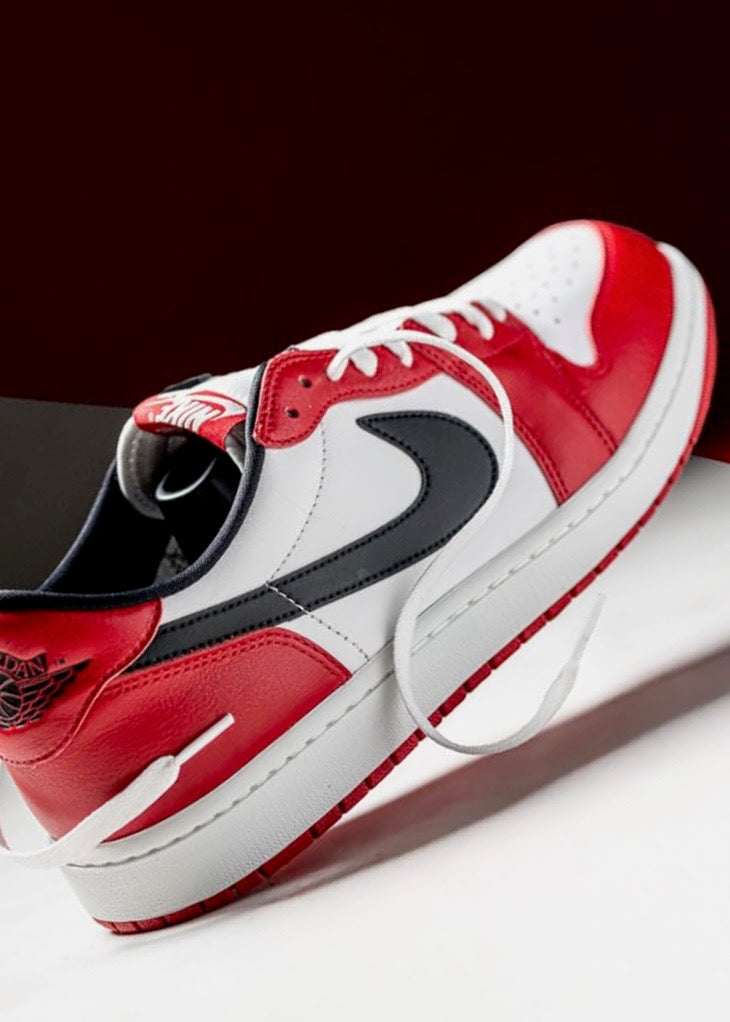Ask a room full of sneakerheads which shoe “started it all” and the Air Jordan 1 usually pops up before you even finish the sentence. Narrow it down to the red, white, and black Chicago colorway and you’re not just talking about a sneaker anymore, you’re talking about a cultural anchor. What makes the Jordan 1 Chicago so influential isn’t just the stories everyone already knows. It’s the way this shoe quietly trained us to treat sneakers less like gym equipment and more like something you protect, preserve, and pass on.
When the Jordan 1 dropped in 1985, designed by Peter Moore and sold for $65, it sat perfectly between performance and fantasy. It was a serious basketball shoe built for Michael Jordan’s explosive game, but it also gave everyday fans a literal piece of his rise. On top of that, the Chicago colorway carried the Bulls’ identity on your feet, whether you lived on the South Side or halfway across the world. It wasn’t just “a red shoe”; it was a portable slice of Chicago.
Over time, that story turned into a masterclass in value. Kids hooped in their Chicago 1s, skated in them, beat them into the ground. Then, decades later, those same pairs started resurfacing in vintage shops, auctions, and online marketplaces. Resale data shows the Air Jordan 1 dominating the secondary market, one analysis suggests the AJ1 makes up roughly a quarter of the whole resale space, and platforms like StockX have consistently crowned it their most traded model. The Chicago colorway sits near the center of that storm. A shoe that once felt like a regular release evolved into the blueprint for treating sneakers as long-term assets, wearable archives instead of fast fashion.
That shift in how we see value sparked an entire care and restoration movement. Suddenly, people weren’t just flexing; they were obsessing over heel drag, toe-box creasing, and cracked leather like car enthusiasts talk about paint and mileage. Vintage 1985 Chicago 1s getting resoled, reconditioned, and carefully de-yellowed pull in massive audiences. Those before-and-after pics aren’t just content; they’re small conservation projects. The underlying belief is simple: this shoe deserves another life. That mindset - protect, repair, preserve - is a huge foundation of today’s sneaker-care culture and the evolving idea that extending a shoe’s life is its own form of innovation.
Nike eventually gave a quiet nod to that community with the 2022 “Lost & Found” Jordan 1 Chicago. Instead of dropping some futuristic remix, they leaned into nostalgia: cracked leather, yellowed midsoles, and packaging that mimics a pair rediscovered in a dusty mom-and-pop stockroom. It was basically an official love letter to everyone who’d spent years digging through basements, storage units, and eBay listings looking for original Chicagos. The message? The real magic isn’t just how a sneaker looks fresh out of the box, it’s how it survives time.
Even the myth-making around the Chicago 1 changed how sneaker culture tells stories. For years, the “banned” narrative blurred the lines between the AJ1 and the Nike Air Ship. Later archival work showed it was the black-and-red Air Ship, not the Chicago 1, that broke the NBA’s uniform rules. Instead of dulling the hype, that correction actually leveled up the fandom. People dove into old photos, game logs, marketing campaigns, and side-by-side comparisons. Deep-dive threads and long-form videos untangling what was actually banned became standard. The Chicago 1 helped turn sneakerheads into historians, making fact-checking and research a core part of the culture instead of just trivia.
Modern collaborations keep that legacy alive through purposeful reinterpretation. Deconstructed takes like Off-White’s AJ1 or Union LA’s hybrid Chicago-inspired pairs don’t just remix the color blocking because it “sells.” They use that familiar red, white, and black as a canvas to talk about DIY culture, heritage, and community while still saluting the original blueprint. The Chicago 1 became the reference point that lets new ideas feel fresh and rooted at the same time.
In the end, the Jordan 1 Chicago didn’t just ignite sneaker culture, it matured it. It taught people that shoes are worth caring for, arguing about, researching, and preserving. It showed us that a sneaker can hold history, hometown pride, and personal memories all at once.
And for a shoe-care brand like ours, that’s exactly why this pair matters so much. The Chicago 1 is the unofficial origin story of modern sneaker care: the shoe people refused to “just wear out,” the one they boxed back up, cleaned after every session, stuffed, reshaped, and tried to keep crisp for as long as possible. It’s the reason sneakerheads started treating their kicks like collectibles, not just beaters. That same energy, valuing what you wear, extending its life, and honoring the story in every crease, is the heartbeat of what we do.
If the Jordan 1 Chicago taught the world to care about a sneaker, our job is to help make sure every pair you love gets that same level of respect.



Share:
'Friends in the Flow' Creator Spotlight – Seretouil
'Friends in the Flow' Creator Spotlight – BaddestMonkey